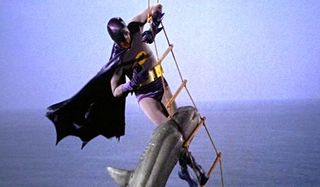Follow The Evolution Of Batman Through Cinema In Epic Fan-Made Video

Ever since Batman’s introduction to the world of popular culture in the pages of the May 1939 issue of Detective Comics #27, the brooding cave-dwelling dispatcher of disorder has managed to capture the imagination of people around the world and is undoubtedly one of the most iconic characters in history. Certainly, all of that has been magnified exponentially by his influence in the live-action capacity, namely the cinema. To help drive that point home, a fan would throw together this amazing and powerful supercut chronologically detailing the Caped Crusader’s evolution on the big screen, dating back from 1943 to present.
The video brought to us by Batman fan Jacob T. Swinney, is quite a ride and also serves to illustrate not just the aesthetic and thematic advances in the last 72 years, but also just how cyclical the various approaches to Batman seem to be over the generations. It’s never more evident than when viewing the various iterations of the Dark Knight, stacked upon one another in one informative sitting.
It begins with the very first live-action Batman in the form of the 1943 serial. While the Batman character had existed in the pages of comics for 4 years and even had gained mainstream focus with a newspaper comic strip, Batman’s big screen debut in the 15 chapter serial (historically played at theaters in individual small chapters before feature presentations,) would mark the hero’s cowl-covered coming out party with Lewis Wilson in the Bruce Wayne/Batman role. What’s evident even in the montage, is that while it was corny-looking by any conceivable standards of the last 50 or so years, it still managed to convey the expressionist, noir-infused atmosphere of the early Batman comics, which focused more on the "detective" aspect before the days of over-the-top supervillains. The next iteration, another 15 chapter serial in 1949 called Batman and Robin, with Robert Lowery taking the Bat-mantle, wasn’t all that different. However, you can see subtle changes in the approach, especially when it comes to the growing array of disbelief-suspending, deus ex machina-making devices in Batman’s utility belt. It did seem that Batman had gotten just a little less serious.
Batman would go on hiatus for a good while, only to return famously in the hugely-successful 1966 Batman television series starring Adam West. In the 17-year break, Batman had undergone quite a change in tone, specifically in the comic books during the 1950’s which had evolved into a silly campy style, culminating in the appearances of the impish, flying Batman-dressed extra-dimensional being, Bat-Mite. It was clear that people had stopped seeing Batman as a brooding vigilante and more as a colorful whacker of flamboyant whippersnappers. The Adam West version on television and the 1966 off-shoot film took those attitudes and turned up the camp to a level that started as satirical sarcasm, but fell way too deep down the rabbit hole.
Subsequently, in what was likely a direct reaction to that show’s campiness, the 1970’s and 1980’s would see a dark, violent reinvention of the Batman comic books. They would begin displaying the Dark Knight as a more tortured individual, fighting villains that were a lot more than just flashy costumes carrying out "dastardly" plots, but rather, were genuine murdering psychopaths. This would set the tone for Batman’s reinvention in the seminal 1989 Tim Burton-led Batman film in which comedian, Michael Keaton surprised the world with his gravitas in the Bat-cowl.

As we further saw, the Keaton era indelibly set the benchmark for the serious live-action Batman, which would give way to a sequel and the popular animated series and its film off-shoot, Batman: Mask of the Phantasm. However, when Joel Schumacher took over what was the Burton film franchise, giving us Val Kilmer in Batman Forever and then George Clooney in Batman & Robin, we saw yet another tonal turn backwards towards campiness. While not quite as extreme as the Adam West days, it plays to idea that seems on display in Swinney’s supercut; namely that as much as Batman changes throughout the times, the pendulum of pop culture also seems to swing him back and forth towards different sides of the spectrum of humor and seriousness. Schumacher’s absurdity would create a post-millennium consumer need for the more recent, dark, ultra-brooding, character-centric Christopher Nolan films with Christian Bale’s grizzle-voiced avenger of dead parents.
Interestingly, the montage would leave us with Batman’s latest on-screen appearance, which was actually in a humorous context in a plastic form that notoriously damages the feet of parents around the world in last year’s The Lego Movie. It does make one wonder which direction the pendulum will have Batman swing when the upcoming Batman v Superman: Dawn of Justice brings us Ben Affleck as our new Caped Crusader hitting theaters on March 25, 2016.
CINEMABLEND NEWSLETTER
Your Daily Blend of Entertainment News
Most Popular







